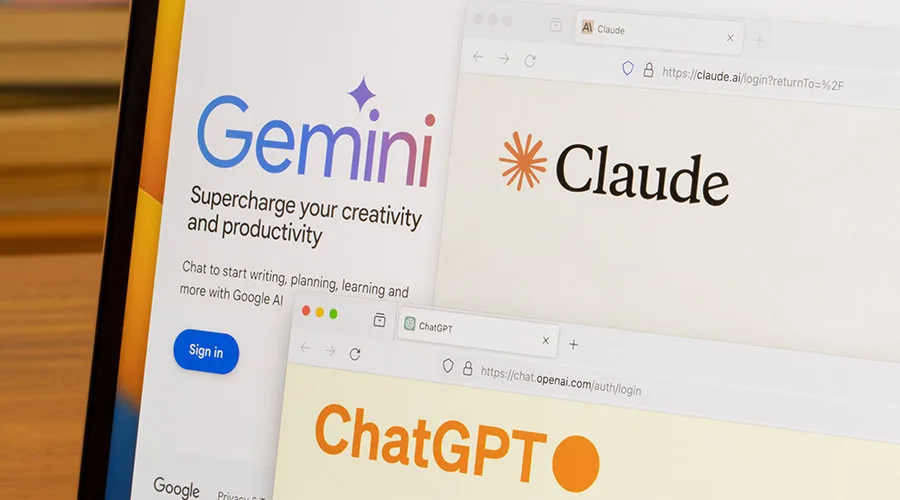- Large language models are built on machine learning. They are designed to analyze large sets of data and can interpret human language.
- Examples of large language models include ChatGPT, Gemma, Cohere and more.
- Large language models and artificial intelligence are related but not the same concept, as they work together.
Table of Contents
In recent years, large language models (LLMs) have become a growing topic in the world of technology. These models are advanced computer programs designed to understand and generate human language, similar to what an actual human response would be. Imagine talking to a computer and having it give you a reply very similar to that of a human. LLMs are used in various applications, such as chatbots, translation services and even creative writing.
This introduction will explore what an LLM is and how these models work, nine examples of LLMs and lastly, how these models differ from artificial intelligence (AI).
How Do Large Language Models Work?
LLMs function by learning from vast amounts of data they process and store. These models are designed to use this knowledge to understand and generate text in a way that makes sense for humans to understand. They are built using a type of AI called machine learning. During training, they analyze patterns in the text to learn grammar, facts and even the context of different words.
When you ask a question or give a command, the model predicts the most likely response based on what it has learned. It is like having a conversation with someone who has an incredible memory and can respond quickly and accurately.


Get Industry leading insights from Robert F. Smith directly in your LinkedIn feed.
Get Industry leading insights from Robert F. Smith directly in your LinkedIn feed.
Nine Examples of Large Language Models
Have you ever wondered how chatbots and language tools work? They are fueled by LLMs working to make everything happen behind the scenes. In this section, we will explore nine examples of LLMs, including understanding well-known LLMs like ChatGPT, Turing-NLG and Gemma.
1. ChatGPT
The most commonly used LLM, ChatGPT, was developed by OpenAI. This LLM is specifically designed to generate human-like responses based on the input it receives from the user. You can ask it questions, have it help create content ideas or even create stories. It is similar to having a conversation with a very knowledgeable friend who can help you with various tasks.
2. Cohere
Cohere is another powerful LLM that primarily focuses on natural language understanding and generation within enterprise data. It is a well-known AI platform used specifically by businesses and corporations to help analyze customer feedback, generate content and improve overall communication with customers. Cohere aims to make it easy for developers to integrate its advanced language capabilities into its established applications.
3. Turing-NLG
Turing-NLG, or also known as T-NLG, was developed by Microsoft and is now one of the LLMs used worldwide. This model is capable of predicting the natural flow of human language. It excels at understanding and generating text, making it useful for tasks like natural language processing (NLP), translating, summarizing text and answering questions. Its sheer size allows it to perform well on a wide range of language tasks.
4. LangChain
LangChain is a unique LLM designed to handle complex chains of language-based reasoning. It is particularly useful in applications that require multi-step reasoning, such as solving math problems or figuring out logical puzzles. LangChain helps break down these tasks into manageable steps for improved accuracy.
5. T5
T5, or Text-to-Text Transfer Transformer, is a model created by Google AI. It treats all language tasks as converting input text into output text, making it versatile for various applications like translation, summarization and even answering questions. T5’s flexibility makes it a popular choice for many NLP tasks.
6. BERT
BERT, abbreviated for Bidirectional Encoder Representations from Transformers, is another model by Google AI. It is designed to understand the context of words in a sentence by looking at the words before and after them. This makes BERT very effective for tasks like answering questions and analyzing sentiment.
7. Claude
Claude is an LLM developed by Anthropic and was designed to prioritize safety and alignment with human values. It has the ability to recognize patterns in large sets of data and then focuses on providing accurate and ethical responses. This makes the model suitable for applications where responsible AI behavior is crucial. Claude is commonly used in various scenarios to ensure that AI interactions remain trustworthy and AI bias is lessened.
8. LaMDA
LaMDA, which stands for Language Model for Dialogue Applications, is another LLM by Google AI. It is specifically designed for engaging in natural and open-ended conversations. LaMDA can handle a wide range of topics and provide informative and coherent responses, making it ideal for chatbot applications.
9. Gemma
Gemma is a LLM known for its versatility and efficiency in generating and understanding text. It is used in various applications, from customer service to content creation. Gemma aims to provide high-quality language capabilities while being efficient enough to run on smaller devices, making it accessible for many different uses.
Other Use Cases for LLMs
LLMs have a wide range of applications beyond chatbots and text generation. In education, LLMs assist with tutoring and providing personalized learning experiences. They also play a crucial role in content creation, helping writers brainstorm ideas and improve their work. In healthcare, LLMs can analyze medical records and provide insights for better patient care. Additionally, businesses use LLMs for customer support, automating responses to common queries and improving overall efficiency. LLMs are versatile and adaptable, making them valuable tools across many industries.
What Is the Difference Between LLMs and AI?
LLMs and AI are related in some ways, but they are not exactly the same thing. AI is a broad field that includes machines or computer programs capable of performing tasks that typically require human intelligence. They can learn, reason, solve problems and make decisions.
On the other hand, LLMs are a specific type of AI focused on understanding and generating human language. Think of AI as the overall concept, like a toolbox, and LLMs as one of the specialized tools inside the AI toolbox.
AI can include many other technologies, such as image recognition, robotics and game-playing programs. LLMs are all about processing and creating text.
Stay up to date with the latest developments in LLMs and AI by following Robert F. Smith on LinkedIn.






